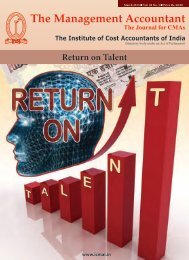This Issue - Icwai
This Issue - Icwai
This Issue - Icwai
Create successful ePaper yourself
Turn your PDF publications into a flip-book with our unique Google optimized e-Paper software.
International Merger and Acquisition : An Overview<br />
on the Cultural Clash<br />
Introduction<br />
MERGER MERGER AND AND ACQUISITION<br />
ACQUISITION<br />
In the last two decades, international mergers and<br />
acquisitions (M&A) have been a popular choice<br />
of overseas market entry (Kiessling and Richey,<br />
2005). M & A are not confined in a particular country,<br />
rather it is widely pervasive. China participated in the<br />
venture from 1978 (Kleinburg, 1990), with the rise of<br />
free trade agreements and economic growth in South<br />
East Asia. More recently, Indian companies are<br />
beginning to launch overseas takeover significantly<br />
(Financial Times, 1st July 2007). M&A allow companies<br />
to achieve greater market power, overcome barriers<br />
to entry, enter new markets quickly, and to acquire<br />
new knowledge along with resources (Vermeulen and<br />
Barkema, 2001). It is to be mentioned here that M&A<br />
are not necessarily the only way of expanding business<br />
or of entering new markets. There are also other modes<br />
of entry into international market like joint ventures or<br />
strategic alliances.<br />
International market entry through M&A has also<br />
some demerits. M&A require additional costs<br />
(premium and advisory cost) for acquiring firms<br />
(Moeller, 2007). Admittedly, the success rate of M&A<br />
is relatively very low (Quah and Young, 2005). The<br />
evidence suggests that the intended benefits of<br />
acquisition are often not realized (Pablo, 1994). The<br />
acquiring firm exhibits poor performance in terms of<br />
both accounting and stock market based measures.<br />
Failure of M&A<br />
Mergers and Acquisitions seem to appeal more<br />
business than pure organic growth. In spite of heavy<br />
risk, M & A are preferred to increase profitability and<br />
market share. According to Cartwright and Cooper<br />
(1993), only half of all mergers and acquisitions met<br />
initial expectations. Ravenscraft and Scherer (1989)<br />
found that the profitability of acquired firms declined<br />
after acquisition. Moreover, most of the acquired firms<br />
are later divested or sold off for their unsatisfactory<br />
S. M. Salamat Ullah Bhuiyan*<br />
Mohammed Shahedul Quader**<br />
Shanto Banik***<br />
performance (recent example include divestments<br />
within the automotive industry by Daimler and Ford,<br />
2006/07).<br />
The failure of M & A can be attributed to a number<br />
of factors. These attributes include : a) over inflated<br />
purchase price, b) strategical mismatching, c) poor<br />
financial management and incompetence and d)<br />
failure to achieve projected earning ratio (Cartwright<br />
and Cooper, 1992).<br />
Bettis and Prahalad (1995) identified motivational<br />
problems in M & A. They also identified that<br />
technology, rules, procedures, conventions, beliefs,<br />
culture, and knowledge of acquired firm differ from<br />
those of the acquiring firm. There are also the<br />
problems associated with planning and managing the<br />
integration process (Haspeslagh and Jemison, 1991).<br />
There are differences in organizational culture and<br />
management style and these factors lead to failure of<br />
the newly formed company (Vermeulen and Barkema,<br />
2001; Quah and Young, 2005). In case of M&A,<br />
differences in corporate culture have also been<br />
identified (Weber et al, 1996). The effects of cultural<br />
clash can decrease the commitment and cooperation<br />
of acquired employees (Buono et al, 1985). As a<br />
consequence, shareholders’ value of buying the firm<br />
is dropped (Chatterjee et al, 1992), and the performance<br />
of acquired firm is poor (Very et al, 1997;<br />
Weber, 1996).<br />
Cultural Clash in M & A<br />
Cultural clash is one of the vital elements that<br />
* Professor, Department of Marketing Studies & International<br />
Marketing, University of Chittagong,<br />
Chittagong, Bangladesh<br />
** Assistant Professor, Department of Marketing Studies<br />
& International Marketing University of Chittagong,<br />
Chittagong, Bangladesh<br />
*** Lecturer, Department of Marketing Studies & International<br />
Marketing, University of Chittagong,<br />
Chittagong, Bangladesh<br />
790 The Management Accountant |September 2011




